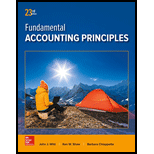
Introduction:
Common Stock refers to securities which give its holders a share in the ownership of a corporation. Common stockholders have voting rights and they can elect the board of directors of a corporation.
Requirement 1:
To Calculate:
Current Market Value of Common Stock
Answer to Problem 5BPSB
Solution:
Current Market Value of common stock is $90 per share. Therefore, the total market value will be calculated as follows:
Explanation of Solution
Explanations:
Market Value is nothing but the current price prevailing in the stock exchange. So, the current market value would be $ 90 per share and the total market price of 18,000 shares would be $1,620,000.
Requirement 2:
To Calculate:
Par Value of
Answer to Problem 5BPSB
Solution:
Par Value of Preferred Stock is $250 per share and par value of common stock would be $50 per share.
Explanation of Solution
Explanations:
Given:
Total Value of Preferred stock = $375,000
Number of Preferred Stock = 1,500
Therefore,
Total value of Common Stock = $900,000
No. of Common Stock = 18,000
Therefore,
Requirement 3:
To Calculate:
Book Value per share of Common Stock if no dividends are in arrears
Answer to Problem 5BPSB
Solution:
If no dividends are in arrears, the book value per share of common stock would be $112.5.
Explanation of Solution
Explanations:
Book Value per share is calculated as follows:
Requirement 4:
To Calculate:
Book Value per share of Common Stock if two years preferred dividends are in arrears
Answer to Problem 5BPSB
Solution:
If two years preferred dividends are in arrears, the book value per share of common stock would be $109.17.
Explanation of Solution
Explanations:
Preferred dividends of two years would be calculated as follows:
Therefore, Book Value per share is calculated as follows:
Requirement 5:
To Calculate:
Total amount of dividend to be paid to the Preferred and Common shareholders and Dividend per share for Common Stock
Answer to Problem 5BPSB
Solution:
Total amount to be paid to the Preferred shareholders = $90,000
And, Total amount to be paid to the Common shareholders = $10,000
Dividend per share for Common Stock would be $0.56 per share.
Explanation of Solution
Explanations:
Two years arrear preferred dividend = $60,000 (as calculated above)
Current year preferred dividend = $30,000
Therefore,
Since, Total Dividend declared is $100,000 (given). Therefore, total amount of dividend to be paid to common shareholders would be as follows:
Therefore, dividend per share for common stock would be calculated as follows:
Requirement 6:
To Determine:
Reasons for common stock not being always a good estimate of its market value
Answer to Problem 5BPSB
Solution:
Book Value is not always a good estimate of market value because market value is the price prevailing in the stock market whereas Book Value is the value appearing in the books of accounts of a company.
Explanation of Solution
Explanations:
Book Value represents the real net worth of the company. On the other hand, Market Value represents the net worth of company as per investors’ point of view. Book Value is generally the value appearing in company’s books of accounts whereas Market Value is the value appearing in stock market.
Book Value is calculated by dividing the
Hence, by seeing the book value of common stock we cannot estimate the market value of it because both the values may be different from each other as they are calculated in a different way.
Want to see more full solutions like this?
Chapter 13 Solutions
Fundamental Accounting Principles
- Please explain the solution to this general accounting problem with accurate principles.arrow_forwardPlease provide correct solution and accounting questionarrow_forwardWhat is the rate of return for an investor who pays $963.88 for a three-year bond with an 8.2% coupon paid annually and a face value of $1,000 and sells the bond one year later for $1,016.667?arrow_forward
- I need help solving this general accounting question with the proper methodology.arrow_forwardThe canon of _________ advocates that a tax has to be contrived as a mechanism that takes as little as possible out of the pockets of the people and to pay as little as possible over and above what it brings into the public treasury of the state. A.Convenience B.Certainty C.Equity D.Economyarrow_forwardPlease provide the accurate answer to this general accounting problem using valid techniques.arrow_forward
- All of the following are applicable in determining corporate domicile when claiming diversity jurisdiction except: A.the place where high level officials meet for activities B.the place where the coordination of corporate strategy and daily activities are carried out C.the place where cardinal activities of business are carried out D.the place where the corporation makes most of its profitsarrow_forwardCalculate the net profitarrow_forwardThe Tax Authority has the power to make an assessment, to the best of its judgment, in all but one of the following circumstances: A.Where the taxpayer has not filed a return B.When the tax authority has to compare previous tax returns filed by the taxpayer to industry standards in making their assessment C.When documents exist to accurately compute the tax liability D.If the department considers that the taxpayer has not declared all of their revenuearrow_forward

 AccountingAccountingISBN:9781337272094Author:WARREN, Carl S., Reeve, James M., Duchac, Jonathan E.Publisher:Cengage Learning,
AccountingAccountingISBN:9781337272094Author:WARREN, Carl S., Reeve, James M., Duchac, Jonathan E.Publisher:Cengage Learning, Accounting Information SystemsAccountingISBN:9781337619202Author:Hall, James A.Publisher:Cengage Learning,
Accounting Information SystemsAccountingISBN:9781337619202Author:Hall, James A.Publisher:Cengage Learning, Horngren's Cost Accounting: A Managerial Emphasis...AccountingISBN:9780134475585Author:Srikant M. Datar, Madhav V. RajanPublisher:PEARSON
Horngren's Cost Accounting: A Managerial Emphasis...AccountingISBN:9780134475585Author:Srikant M. Datar, Madhav V. RajanPublisher:PEARSON Intermediate AccountingAccountingISBN:9781259722660Author:J. David Spiceland, Mark W. Nelson, Wayne M ThomasPublisher:McGraw-Hill Education
Intermediate AccountingAccountingISBN:9781259722660Author:J. David Spiceland, Mark W. Nelson, Wayne M ThomasPublisher:McGraw-Hill Education Financial and Managerial AccountingAccountingISBN:9781259726705Author:John J Wild, Ken W. Shaw, Barbara Chiappetta Fundamental Accounting PrinciplesPublisher:McGraw-Hill Education
Financial and Managerial AccountingAccountingISBN:9781259726705Author:John J Wild, Ken W. Shaw, Barbara Chiappetta Fundamental Accounting PrinciplesPublisher:McGraw-Hill Education





